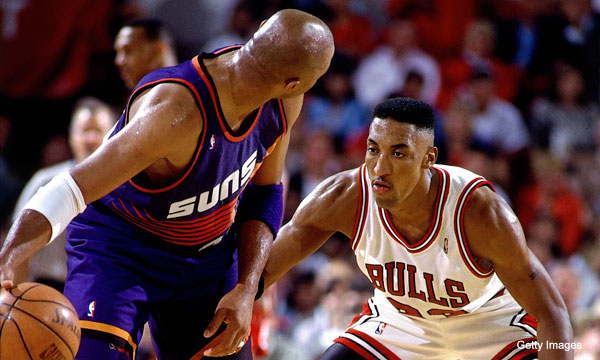
- Foreign Policy - August 9, 2021
- Rebounding For The Win - July 23, 2021
- NBA Legacy – Rising Sun - July 16, 2021
[author image=”https://www.the3pointconversion.com/wp-content/uploads/2016/01/EAR_Headshot-e1454263687203.jpeg” ] Eric Rodas [/author]
A question was posed to me the other day by a young fan of basketball. He asked me if it was more difficult to play defense in the 1980’s than it is in today’s game. Now, my knee jerk reaction, as with many other topics between then and now, was to let him know how ridiculous that question was and how everything was harder or better back then. The fact that he was sincere with his inquiry held my bitter old man rants at bay and allowed me to actually contemplate what he was asking. My answer was, “Good question.” I can honestly say that there has been a significant metamorphosis to what we considered defense from the aforementioned era to today’s version of it.
First, we will examine the team concept of defense. Everyone knows that the defense in the 80’s was man-to-man. This means you had to be within a reasonable distance from your assigned player with out just standing in an area on the court. You were not allowed to double team players that did not posses the ball. Players were allowed to help but could not just stand half way between their assignment and the player whom had ball. This is why the court had, and still has, hash marks which allowed referees to determine legal defensive positioning. Switching defensive assignments was also allowed during screen action, double teams and defensive rotations. This meant that you had to constantly make sure you were in the right spot. With the advent of the zone, players are now allowed to sit in that space between their assigned player and the ball handler, which in turn makes it easier for them to help rotate, switch all screen action and double team the ball.
Next, let’s examine the individual aspects of these two contrasting eras of defense. Although you were allowed to use your hands as part of defense back then, you were not allowed to hold or push a player. Hand checking was strictly for helping you assert and maintain proper defensive distance between you and your assigned player. You had to move your feet in order to stay in front of your defensive assignment. Physical play was allowed but it had to be initiated by sound footwork. Today’s game has certainly designed the rules to be more advantageous for the offensive player. The elimination of physical contact and the passive enforcement of ball handling rules such as palming and carrying the ball make it almost impossible to play on the ball defense.
The philosophy of coaches towards defense has changed as well during this time line. Ever since I can remember, the measuring stick for achieving the next level of play was your ability to defend. If you can’t guard anybody at this level, you can’t play at this level. It was like the difference between the 1990 NCAA Champion University of Nevada Las Vegas (UNLV) team versus the Loyola Marymount University (LMU) team of that same year. UNLV played tough defense and LMU was more offense oriented with no attempt at guarding anyone. Then came the Mike D’Antoni coached Phoenix Suns where defense was not a priority. It was no coincidence that during these years there was less attention to defensive fundamentals. Even at the high school level teams are choosing to play zones as opposed to man-to-man. This has developed a negative perspective about defense.
As I continued on my history lesson about the evolution of the game, I was beginning to lose the attention of my audience. He had this look on his face that said he was getting more than he had bargained for. So I answered him with this statement. Although aspects of the game have changed with time, I can only say that defense was different but not any better or any worse. It would seem that the degree of difficulty would have more to do with the individual athlete then on the era of play. The young man smiled and went off with his friends.




